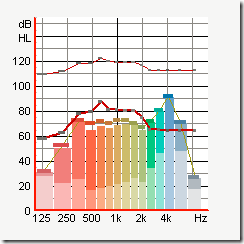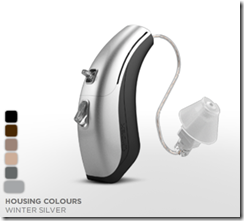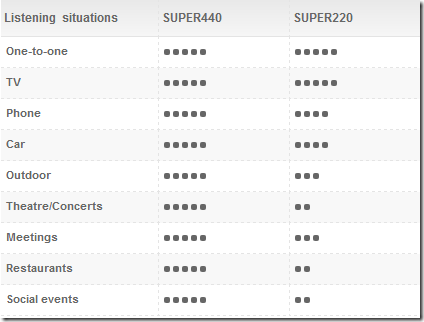Fine-tuning tips & tricks for SUPER
Introduction
This bulletin is concerned with the handling of specific issues that may occur during the fitting and fine-tuning of WIDEX SUPER hearing aids. The first section deals with minimising feedback. The following sections deal with adjusting the volume individually in the left and right ear, choosing between different speech and noise modes, and choosing between different AO C settings.
Minimising feedback
The feedback cancelling system in Widex hearing aids is extremely efficient at controlling dynamic feedback problems. Even so, people with severe to profound hearing loss may occasionally experience feedback due to the large amounts of amplification provided by their hearing aids. To minimise feedback, it is recommended to go through one or more of the following steps:
1. Tightly fitted earmould
in the ear canal Feedback can be minimised in high-power fittings with an earmould providing a tight fit in the ear canal. If the earmould is not tightly fitted into the ear canal, the large amounts of amplification needed to ensure audibility of, not just soft sounds, but also normal and loud sounds, can cause feedback. The feedback cancelling system constantly works to obtain the largest possible amount of amplification. However, when the acoustic path changes, for instance when chewing, the feedback canceller has to adapt to the new condition. While this adaptation is taking place, feedback can occur.
2. Sensogram measurements and feedback test
It is recommended to perform Sensogram measurements to ensure that the effect of the earmould, the size of the individual ear canal and the hearing loss are taken into account when the correct gain is calculated. Furthermore, it is recommended to always perform a feedback test when fitting clients with severe to profound hearing loss. During the fitting session it is important that the earmould is inserted in the same way that the user normally inserts it. This will ensure that the result of the feedback test is reliable in relation to daily use.
3. Deep ear canal impressions beyond the second bend
Earmoulds for super-power users must fit deeper into the ear canal than earmoulds used for other groups of hearing aid users. When the earmould impression is taken, make sure that it reaches all the way to the second bend in the ear canal.
4. Adjusting gain in Compass
Because of the magnitude of the clients’ hearing losses, a very large amount of amplification is applied for soft sound levels. As a result, even with a tightly fitted earmould, feedback can occasionally occur in quiet surroundings and environments with soft sound levels. This problem can be solved by identifying the specific frequency region in which the feedback occurs and reducing gain in that region. The region can be identified by means of a feedback test in Compass.
In the example below, there is limited available gain in the frequency region around 4 kHz on the left ear. This indicates that the risk of feedback is greatest in this specific region.
 Fig. 1. The feedback test shows limited available gain around 4 kHz. This is an indication that feedback is most likely to occur in that particular region.
Fig. 1. The feedback test shows limited available gain around 4 kHz. This is an indication that feedback is most likely to occur in that particular region.
The SoundTracker also provides information about which frequencies should be given less gain to avoid feedback. By watching the SoundTracker while simultaneously provoking feedback, it is possible to identify the specific frequency region. In figure 2, feedback occurs in the frequency region around 4 kHz, which is indicated by the peak of the specific channel.
Fig. 2. The SoundTracker indicates occurrence of feedback around 4 kHz.
When the specific frequency region has been identified, the gain for soft sounds should be reduced by a minimum of 3 dB in the relevant region. If further adjustment is needed, it is recommended to do it in steps of 1 dB at the time. If adjusting the gain for soft sounds is not permitted, adjusting the gain for normal sounds may be relevant. It should be pointed out that gain reductions will inevitably reduce the audibility achieved by the hearing aid user, so these should always be kept to a minimum.
It is not recommended to choose ‘Limited audibility for soft sounds’ in the Gain settings window in Compass. This setting reduces gain for all frequencies, not just within the specific frequency region where feedback occurs. This setting will therefore cause a general reduction in audibility across the entire frequency range.
Fig. 3. It is not recommended to change the mode for soft sounds. Instead, adjustment of gain for soft sounds should be restricted to the specific frequency region where feedback occurs.
Adjusting volume individually in the left and right hearing aid
Unlike hearing aid users with less severe hearing loss, super-power users often need to be able to adjust the volume individually in the left and the right ear. The MDEX can be recommended for this purpose. With the M-DEX, the hearing aid user is able to make a large number of individual adjustments, including separate volume changes in the left and right ear. The other InterEar features are not affected by this option in the M-DEX.
Fig. 4. With the M-DEX it is possible to change volume separately in the left and right ear.
If an M-DEX is not an option, fitting two SUPER hearing aids as two monaural fittings is another option. The procedure for this involves detecting and fitting each hearing aid separately in Compass. Once a hearing aid has been detected, it is important to select the binaural fitting rationale in the Rationale conditions window, as Compass will automatically select the monaural fitting rationale if only one hearing aid has been detected.
Fig. 5. The fitting rationale must be changed from Monaural to Binaural if a pair of SUPER hearing aids are fitted individually in Compass.
If the user is to have a remote control, it must be matched to both hearing aids. The user can adjust the volume individually in the left and right hearing aid by means of the volume control buttons on the aids, to achieve the required balance. The user can subsequently use the remote control to change the volume simultaneously in both aids while maintaining the balance that was achieved by individual adjustments of each aid. The user-defined balance will be reset when the user chooses another listening program.
Choosing between different noise reduction modes
Internal trials have shown that super-power users fitted with SUPER hearing aids prefer the Noise Reduction setting. In Compass, the default speech and noise mode is therefore Noise Reduction when SUPER is fitted with an SP-receiver. On the other hand, if SUPER is fitted with a P-receiver for a client with a less severe hearing loss, the Speech Enhancer is the default noise reduction, as with other Widex hearing aids. In our internal trials, severely-to-profoundly impaired participants fitted with the SP-receiver found the Noise Reduction setting more comfortable than the Speech Enhancer.
This is most likely a result of the users’ speech discrimination ability and degree of hearing loss. The Speech Enhancer is adjusted according to the degree of the hearing loss, and focuses on optimised speech intelligibility in every instance. If the hearing loss is in the profound category, the Speech Enhancer will therefore be less inclined to reduce gain, even in very noisy sound environments, because its primary aim is to preserve speech intelligibility.
In situations with high noise levels, profoundly impaired hearing aid users may therefore find that the Noise Reduction mode generates a more comfortable sound. If the user has some speech discrimination ability, it may be beneficial to change from the default Noise Reduction setting to Speech Enhancer. On the other hand, if the user has limited speech discrimination ability, retaining the default Noise Reduction mode may be a better choice.
Fig. 6. The default speech and noise mode is Noise Reduction, rather than Speech Enhancer, when users with severe-to-profound hearing loss are fitted with SUPER with an SP-receiver.
Choosing between different AOC settings
SUPER hearing aids can be fitted with two receivers (SP and P). Super-power users have different needs with respect to output, compared to users with less severe hearing loss. A special AO C strategy is therefore introduced for super-power users in connection with SUPER. Thus, instead of having the usual two ’On’ and ’Off’ AO C settings, three settings are available when super-power users are fitted:
• Off
• AO C profound
• AO C normal
AO C normal is the well-known, existing setting where it is possible to adjust in 4 bands (it corresponds to ‘On’ with other hearing aids). Off is for people who need as much sound as possible – even if the signal is distorted. There is no 4-band adjustment option with this setting.
AO C profound is something in between. Because it offers fast regulation, it will enable a higher output level than AO C normal, but the sound quality will be better than with Off. There is no 4-band adjustment option with this setting.
Fig. 7. It is possible to choose between three different AO C settings when fitting SUPER.
The default Automatic Output Control feature is chosen automatically on the basis of the degree of the hearing loss, according to what is estimated to be optimal for the specific degree of hearing loss. If a hearing aid user is not satisfied with the perceived sound quality for loud sounds, choosing another setting could be beneficial.
The Full Audiological Bulletin can be downloaded here Fine tuning tips and tricks for Super












